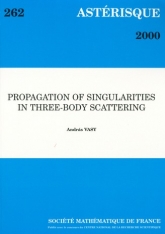Propagation des singularités dans la diffusion à trois corps
Propagation of singularities in three-body scattering

- Consulter un extrait
- Année : 2000
- Tome : 262
- Format : Électronique, Papier
- Langue de l'ouvrage :
Anglais - Class. Math. : 35P25, 58G25, 81U10
- Nb. de pages : 157
- ISBN : 2-85629-082-5
- ISSN : 0303-1179
- DOI : 10.24033/ast.482
Nous considérons une variété $X$ compacte à bord, munie d'une métrique de diffusion $g$ et d'une famille $C_i$ de sous-variétés fermées de $\partial X$ deux à deux disjointes. Ainsi, $g$ est une métrique riemannienne dans $\rm {int}(X)$ de la forme $g=x^{-4}\,dx^2+x^{-2}h$ près de $\partial X$, pour un choix convenable de fonction $x$ définissant le bord, $h$ étant un $2$-cotenseur symétrique ${\mathcal C}^\infty $ sur $X$ qui est non dégénéré en restriction à $\partial X$. Nous notons aussi $\Delta $ le laplacien (positif) de $g$, choisissons $V\in {\mathcal C}^{\infty }([X;\cup _i C_i])$, où $[X;\cup _i C_i]$ est $X$ éclaté le long des $C_i$, tel que $V$ s'annule sur le relevé de $\partial X$, et nous considérons l'opérateur $H=\Delta +V$. Les diffusions à trois corps avec potentiels ${\mathcal C}^\infty $ qui ont un développement asymptotique à l'infini (éventuellement du type de Coulomb) sont des exemples de cette situation. Nous analysons la propagation des singularités des fonctions propres généralisées de $H$ en montrant que c'est essentiellement un problème hyperbolique qui a beaucoup en commun avec les problèmes de Dirichlet et de transmission pour l'opérateur des ondes, avec néanmoins des propriétés supplémentaires dues à la présence d'états bornés des “opérateurs à deux corps". Nous montrons aussi que la relation de front d'onde de la partie libre-libre de la matrice de diffusion est donnée par le flot des géodésiques brisées à distance $\pi $.


